
Droseraceae is a family of carnivorous flowering plants, also known as the sundew family. It consists of approximately 180 species in three extant genera. Representatives of the Droseraceae are found on all continents except Antarctica.

Nepenthes is a genus of carnivorous plants, also known as tropical pitcher plants, or monkey cups, in the monotypic family Nepenthaceae. The genus includes about 170 species, and numerous natural and many cultivated hybrids. They are mostly liana-forming plants of the Old World tropics, ranging from South China, Indonesia, Malaysia, and the Philippines; westward to Madagascar and the Seychelles (one); southward to Australia (four) and New Caledonia (one); and northward to India (one) and Sri Lanka (one). The greatest diversity occurs on Borneo, Sumatra, and the Philippines, with many endemic species. Many are plants of hot, humid, lowland areas, but the majority are tropical montane plants, receiving warm days but cool to cold, humid nights year round. A few are considered tropical alpine, with cool days and nights near freezing. The name "monkey cups" refers to the fact that monkeys were once thought to drink rainwater from the pitchers.

The Venus flytrap is a carnivorous plant native to the temperate and subtropical wetlands of North Carolina and South Carolina, on the East Coast of the United States. Although various modern hybrids have been created in cultivation, D. muscipula is the only species of the monotypic genus Dionaea. It is closely related to the waterwheel plant and the cosmopolitan sundews (Drosera), all of which belong to the family Droseraceae. Dionaea catches its prey—chiefly insects and arachnids—with a "jaw"-like clamping structure, which is formed by the terminal portion of each of the plant's leaves; when an insect makes contact with the open leaves, vibrations from the prey's movements ultimately trigger the "jaws" to shut via tiny hairs on their inner surfaces. Additionally, when an insect or spider touches one of these hairs, the trap prepares to close, only fully enclosing the prey if a second hair is contacted within (approximately) twenty seconds of the first contact. Triggers may occur as quickly as 1⁄10 of a second from initial contact.
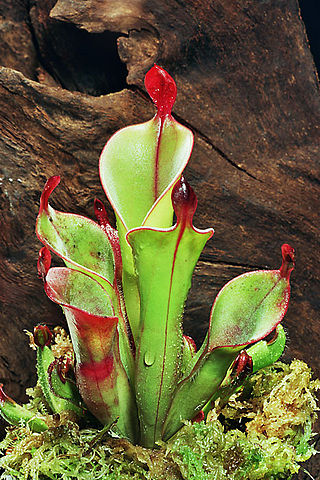
The genus Heliamphora contains 24 species of pitcher plants endemic to South America. The species are collectively known as sun pitchers, based on the mistaken notion that the heli of Heliamphora is from the Greek helios, meaning "sun". The name instead derives from the Greek helos, meaning "marsh", so a more accurate translation of their scientific name would be marsh pitcher plants. Species in the genus Heliamphora are carnivorous plants that consist of a modified leaf form that is fused into a tubular shape. They have evolved mechanisms to attract, trap, and kill insects; and control the amount of water in the pitcher. At least one species produces its own proteolytic enzymes that allows it to digest its prey without the help of symbiotic bacteria.

Drosera regia, commonly known as the king sundew, is a carnivorous plant in the sundew genus Drosera that is endemic to a single valley in South Africa. The genus name Drosera comes from the Greek word droseros, meaning "dew-covered". The specific epithet regia is derived from the Latin for "royal", a reference to the "striking appearance" of the species. Individual leaves can reach 70 cm (28 in) in length. It has many unusual relict characteristics not found in most other Drosera species, including woody rhizomes, operculate pollen, and the lack of circinate vernation in scape growth. All of these factors, combined with molecular data from phylogenetic analysis, contribute to the evidence that D. regia possesses some of the most ancient characteristics within the genus. Some of these are shared with the related Venus flytrap (Dionaea muscipula), which suggests a close evolutionary relationship.

Adrian Slack was a landscape gardener, plantsman, author and authority on carnivorous plants. He won 5 gold medals at the Chelsea Flower Show, and authored two books: Carnivorous Plants and Insect-Eating Plants and How to Grow Them.
Pyrophytes are plants which have adapted to tolerate fire.

Aldrovanda is a genus of carnivorous plants encompassing one extant species and numerous extinct taxa. The genus is named in honor of the Italian naturalist Ulisse Aldrovandi, the founder of the Botanical Garden of Bologna, Orto Botanico dell'Università di Bologna. Aldrovanda vesiculosa has been reported from scattered locations in Europe, Asia, Africa, and Australia.
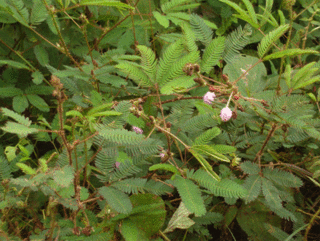
In biology, thigmonasty or seismonasty is the nastic (non-directional) response of a plant or fungus to touch or vibration. Conspicuous examples of thigmonasty include many species in the leguminous subfamily Mimosoideae, active carnivorous plants such as Dionaea and a wide range of pollination mechanisms.

The Carnivorous Plant Newsletter is the official publication of the International Carnivorous Plant Society (ICPS), the largest such organization in the world. It is headquartered in Walnut Creek, California.

Byblis aquatica is an insectivorous plant belonging to the genus Byblis, commonly known as the rainbow plants. It was described by Allen Lowrie and John Godfrey Conran in 1998, assigned to a group of annual north Australian species known as the "Byblis liniflora complex". It grows in semi-aquatic conditions and uses stalked mucilaginous glands covering its leaf surfaces to attract, catch, and digest insect prey to supplement the poor environmental nutrient supply.
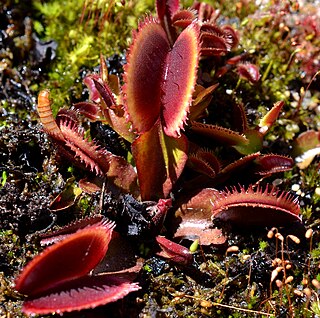
Dionaea muscipula 'Bohemian Garnet' is a cultivar of Dionaea muscipula, the Venus flytrap. It is an F2 cross between Dionaea 'Royal Red' and Dionaea 'Sawtooth' that was published in the September 2007 issue of the Carnivorous Plant Newsletter. In the description of this cultivar, Miroslav Srba noted that it maintains the red coloration of the 'Royal Red' cultivar and most morphological characteristics of 'Sawtooth'. Srba also detailed the smaller size at just 4-6 cm across and the production of many offshoots as novel characteristics that warrant cultivar status. The cultivar name was coined by Srba to honor the country of origin, the Czech Republic (Bohemia), and can be written as Dionaea 'Český Granát'.

Utricularia calycifida is a small to medium-sized terrestrial perennial carnivorous plant that belongs to the genus Utricularia. U. calycifida is endemic to northern South America and can be found in Brazil, Guyana, Suriname, and Venezuela.

Carnivorous plants are plants that derive some or most of their nutrients from trapping and consuming animals or protozoans, typically insects and other arthropods, and occasionally small mammals and birds. They still generate all of their energy from photosynthesis. They have adapted to grow in waterlogged sunny places where the soil is thin or poor in nutrients, especially nitrogen, such as acidic bogs. They can be found on all continents except Antarctica, as well as many Pacific islands. In 1875, Charles Darwin published Insectivorous Plants, the first treatise to recognize the significance of carnivory in plants, describing years of painstaking research.
Dionaea muscipula 'Wacky Traps' is a cultivar of Dionaea muscipula, the Venus flytrap. Dionaea muscipula 'Wacky Traps' was a clone produced by Cresco Nursery in the Netherlands through tissue culture. This particular clone was discovered in a tray of a bunch of mutants by Mike Ross. It has also been called "Bart Simpson," coined by Ed Read, because of the resemblance of the plant to the animated character's spiky hair. The plant is an extremely slow grower. It has abnormally thick traps and petioles, which are probably the reason why 'Wacky Traps' has trouble closing its traps quickly. It takes several minutes trap closure even with repeated teasing of the trigger hairs.
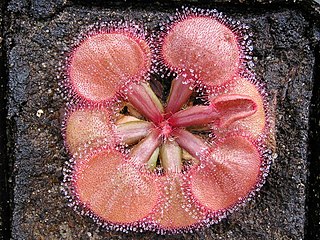
Drosera falconeri is a carnivorous plant in the family of Droseraceae. It is endemic to the Northern Territory of Australia.
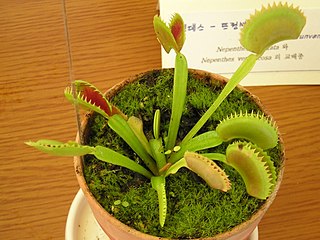
Dionaea muscipula 'Sawtooth' is a cultivar of Dionaea muscipula, the Venus flytrap that has deeply divided "teeth". It was formally described and registered as a cultivar in 2000.
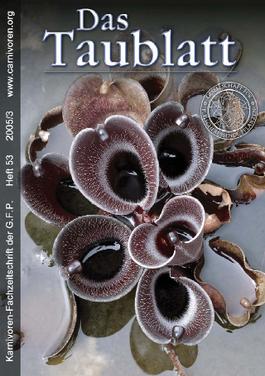
Das Taublatt is a twice-yearly German-language periodical based in Bochum and the official publication of Gesellschaft für Fleischfressende Pflanzen, a carnivorous plant society based in Germany. Typical articles include matters of horticultural interest, field reports, and new taxon descriptions. The journal was established in 1984. It publishes in full colour on glossy paper, with each issue numbering around 52 pages.

The Savage Garden: Cultivating Carnivorous Plants is a carnivorous plant cultivation guide by Peter D'Amato, horticulturist and owner of California Carnivores nursery. It was originally published in 1998 by Ten Speed Press, and reprinted in 2004. A revised edition was released in July 2013.
Plant arithmetic is a form of plant cognition whereby plants appear to perform arithmetic operations – a form of number sense in plants. Some such plants include the Venus flytrap and Arabidopsis thaliana.




















